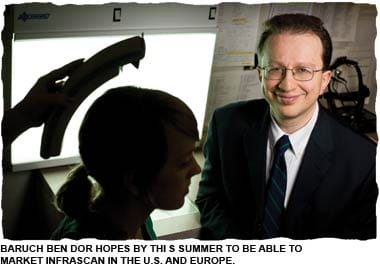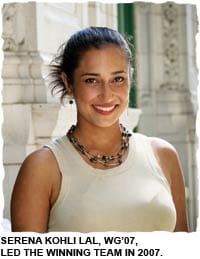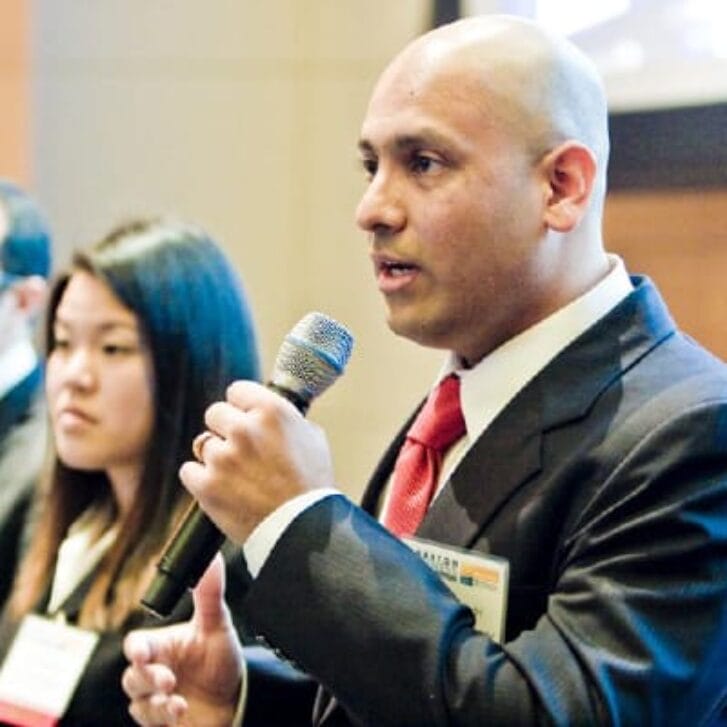After four years of toil, Chris and Natasha Ashton had earned the right to celebrate. Revenue at their company, PetPlan USA, was surging. The Humane Society of the United States had endorsed their pet health insurance policies, and they’d begun hiring employees. They were even the parents of a new baby boy.
Then the life that they’d cultivated since winning the Wharton Business Plan Competition in 2003 nearly ended.
Last summer, a railing across a window at the back of their house in New Jersey gave way as Chris was leaning against it. He tumbled 15 feet to the concrete patio below, smashing his leg and breaking two ribs. He endured four months of recuperation and a patchwork of screws and plates in his ankle before he walked again. Twice, blood clots sent him back to the hospital. “The accident took me out completely,” he recalls. “I was in the hospital for a bit, and I was in immense pain for a couple of months. Thank God for my Blackberry and health insurance.”
Four years earlier, when the Ashtons, both WG’03, won the Wharton Business Plan Competition (BPC) with two classmates, Laura Bennett and Alex Krooglik, they little imagined the twisting path their lives would take. In the wake of winning the BPC, PetPlan’s future seemed assured. But shortly after graduating, they split with their partners, who left to start their own competing company, Embrace Pet Insurance. That forced the Ashtons to divide their former colleagues’ duties. They then had to crisscross the country in search of investors and an insurance underwriter to back their policies. And, just as all of the pieces were coming together, Chris fell.
To the Ashtons’ credit, their fledging business survived and today is growing smartly. Chris has returned to work, and the Ashtons expect that their staff of 11 will grow to 20 by the end of the year. Winning the BPC has helped in each step of their journey, they say. “It’s opened doors for us,” Natasha says.
The details of the Ashtons’ odyssey may be unique, but the rollercoaster ride they experienced is shared by Wharton BPC winners. Victory brings elation and lofty expectations, inevitably followed by the hard, time-consuming work of starting a business or launching a career. Winning, Natasha says, “gives you a rose-tinted view of the world. We thought we’d be up and running within six months.”
“If you’d asked me when I got to Wharton if I was going to win the Business Plan Competition, I would’ve thought you were insane,” says Bennett, also WG’03. “I didn’t know what a business plan was. The BPC changed my life.”
The annual competition, celebrating its 10th anniversary this year, is the signature event sponsored by Wharton Entrepreneurial Programs, the School’s interdisciplinary research and teaching center. “It’s the largest outreach program that we do,” says Emily Cieri, WEP’s managing director. “It’s open to any student at the University of Pennsylvania — graduate, undergraduate, PhD, or medical school.” Each year, the contest touches hundreds of students and Wharton alumni, who act as mentors and judges.
In the fall semester, about 150 teams submit executive summaries of plans for proposed businesses. Judges winnow those down to 25 semi-finalists, who then must submit full-fledged business plans. From the semi-finalists come the eight finalists. The competition culminates each April with the Venture Finals, where the “Great Eight” present their plans to a panel of judges and an audience of their schoolmates. The top three teams receive not only prize money — a total of $35,000 in 2007 — but also in-kind donations of services from Philadelphia-area lawyers, accountants, and business consultants.
Cieri says that professors and staff at WEP like to see competitors start businesses based on their proposals but believe that what students learn from writing and, if they’re lucky, presenting their business plans matters more. “The reality is we see 150 business ideas a year, and those aren’t all going to get started,” she says. “But the educational process is valuable whether the students take corporate jobs, become venture capitalists or start companies.” As this year’s Wharton BPC enters its final phase, the Wharton Alumni Magazine tracked down some of the competition’s top winners from the past 10 years to see where they are today.
For Bennett, of Embrace, business school offered a way to escape the drudgery of a job at a life and health insurance company. Like many students, she and her husband, John Burchard, also WG’03, went to Wharton looking for a new start. During their first year, Bennett met the Ashtons, who were already working with Krooglik, an engineer with database expertise.
By the time the next year’s Wharton BPC rolled around, the team had broken up, partly because of differences over how to divide ownership of the company. The Ashtons stayed in Philadelphia, while Bennett and Krooglik moved to Cleveland, Ohio, where Burchard had landed a job with Progressive Insurance. There, Bennett and Krooglik launched Embrace.
They faced the same obstacles as their former teammates — raising money and finding an underwriter. Their Wharton BPC victory helped with both. “Raising money is a marathon, and the first presentation is the hardest because you have to really think about what investors want,” Bennett says. “The Business Plan Competition made us do that.”
Plus, the experience of pitching to the judges prepared them for the challenge of confronting venture capitalists and other investors, Krooglik says. “You get a first-hand appreciation for what it’s like to stand in front of a room of people and sell,” he notes. “I’ve lost count of how many times we’ve stood up in front of investors, and the questions you get at the BPC are the same style.”
If there’s a key difference between the two audiences, it’s that the Wharton BPC judges give contestants feedback at each stage of the competition. In the real world, investors only offer critiques if they decide to invest. Otherwise, the entrepreneur will hear either a polite no thanks or nothing at all. “Potential investors don’t really tell the truth,” Bennett says. “No one tells you that you have an ugly baby. They always say that it’s not the right baby for them.”
Insurance underwriters are an even tougher audience, she adds. They come from a tradition-bound industry and are paid to avoid risk. (Venture capitalists, in contrast, get compensated for taking risk.) Even so, Bennett and Krooglik managed to land a prestigious underwriter in Lloyd’s of London. “At Lloyd’s, they’re very impressed with credentials,” she explains. “The fact that I was an actuary, that we had Wharton MBAs and had won the competition, all of that mattered to them. It gave them reassurance because they were partnering with a start-up.”
And Embrace, like PetPlan, isn’t without risk. Pet insurance is a promising market — it’s growing at about 20 percent a year — but also an increasingly crowded one. The coverage, long popular in England, has lately begun to catch on in the United States. Embrace estimates that less than one percent of America’s cats and dogs carry coverage, while, in contrast, about half of pets in Sweden do. About 10 companies, all of them small and none with a commanding market share, offer policies in the United States. But more competition is on the way, with Purina, the petfood maker, laying plans to sell policies. Both PetPlan and Embrace believe that, thanks to their unique advantages, they can compete even with a behemoth like Purina. PetPlan has partnered with the leading pet-insurance provider in the United Kingdom, and Embrace has, in Bennett, America’s first pet-insurance actuary.
BPC winners typically focus on raising additional money, as PetPlan and Embrace did, not celebrating the cash that they receive with their victory. After all, a few thousand dollars doesn’t go far for a money-hungry startup. But for Ben Doranz’s company, Integral Molecular, which won in the BPC in 2001, the $25,000 prize money was a real boost.
“Our primary source of start-up funding was grants through places like the National Institutes of Health,” says Doranz, WG’01, who also has a doctorate in microbiology from Penn. “That money only funds the research and can’t be used for things like patents or marketing. So the $25,000 filled in the gap while we raised more money. It went quite far for us.”

Today, Integral Molecular is developing and selling drug-discovery tools for pharmaceutical researchers. The company began as the combination of two business plans that Doranz had entered into the Wharton BPC — one was called ProtoCell, and the other, ViraCore. The ProtoCell plan won, but ViraCore turned out to be easier to commercialize. Doranz ran into a legal pitfall with ProtoCell about a week after his win. While thumbing through a scientific journal, he came across news of a patent for a technology that closely resembled his.
“We got scooped,” he says. “It definitely put a bump in the road. I almost licensed the competing technology. Then a competing company started, and I almost joined them. But in the end, I decided to take a chance and start ViraCore.” He continued to work on distinguishing ProtoCell’s technology from the competing one and, once he did so, staked his legal claim to it. After that, it became Integral Molecular’s second product line.
Biotech firms like Integral Molecular need time to bring their products to market, and keeping a company alive while its technology matures typically requires pitching to outside investors. Like the founders of PetPlan and Embrace, Doranz found that his Wharton BPC win gave him credibility in those discussions. “You’ve been vetted in a sense,” he says. “It doesn’t get you a check from a VC, but it does give you an opportunity. It’s like an introduction from a colleague for a job. It’ll get you the interview but not the job.”
Today, Philadelphia-based Integral Molecular, which employs about 20 people, is selling the ViraCore technology and getting ready to launch the ProtoCell line. The company still depends on scientific grants to fund its operations. Doranz predicts that it will see its first significant sales this year and, by next year, should bring in more money through product sales than grants.
“If we hadn’t won the BPC, there’s a good chance that we never would’ve started,” he adds. “Winning definitely gives you the confidence to get going and validation that you’re doing something worthwhile.”

Unlike Doranz, Baruch Ben Dor already had the confidence to run a company when he won the Wharton BPC in 2004; he’d done so in his native Israel. What he didn’t know was whether he could start one from scratch.
He’d come to Penn as a visiting researcher, hoping that he might find a technology that would serve as foundation of a new firm. His doctorate in physics led him to the laboratory of Britton Chance, an emeritus Penn professor and pioneer in the field of biophysics. There, Ben Dor found what he sought. Chance’s lab had developed a means of using nearinfrared light to pinpoint brain bleeding. In theory, it could help physicians and paramedics diagnose brain injuries more quickly and thus speed treatment.
Thanks to his business experience, Ben Dor was able to write a draft of a business plan on his own. But when he heard about the Wharton BPC, he realized that it offered a way to polish his proposal. He decided to try to enlist the help of Wharton students. Soon, he met Sandeep Naik, WG’04, and Sammonoi Banerjee, WG’05. Naik and Banerjee reworked the plan, which proposed a company, called InfraScan, to develop handheld brain scanners. Naik and Sammonoi did the final presentation before the judges. Like other winners, the team got cash and a blue-ribbon endorsement, which helped in raising money. But Ben Dor says a greater benefit might have been the legal services that winners receive. “The attorney who we met was [Philadelphia lawyer] Steve Goodman,” he says. “He has been one of the most critical elements in building the company. At some of the most critical decision points, I don’t know if we would’ve survived if he hadn’t been there.”
Goodman, for example, smoothed the negotiations that enabled InfraScan to license the technology from Chance’s lab. When the talks turned thorny, Goodman’s long relationship with the lawyer across the table made the difference. “Steve had been the teacher of the attorney that represented the other side,” Ben Dor explains. Goodman, W’62, L’65, is a partner in the Philadelphia office of Morgan, Lewis & Bockius.
In the end, Naik and Banerjee elected not to join InfraScan, which is based in Philadelphia. Like many MBAs, they had school loans to repay and wanted a more certain future. Today, Naik works for Apax Partners, a privateequity firm, while Banerjee is a managerial consultant with McKinsey. They’ve stayed in touch with Ben Dor and help out occasionally on special projects.
InfraScan, for its part, has begun to sell its scanner in the developing world and hopes, by this summer, to receive regulatory approval to market it in the United States and Europe. It has already completed its U.S. clinical trials, which are mandated by the U.S. Food and Drug Administration, and, over the winter, was preparing to make its application for final FDA certification. “Once we get our FDA approval, we’ll do a large round of funding,” Ben Dor says.
Looking back on the BPC, Ben Dor says that it forced him to grapple with just the sorts of issues that he has ended up confronting as an entrepreneur. “We’ve basically done what we laid out in the business plan,” he says. “It took longer than I thought it would — I thought we’d be able to do it in two years, and it took three — but I did it with half the money — $2.5 million, instead of $5 million.”
Like Naik and Banerjee, plenty of BPC winners opt not to start companies based on their business plans. Sometimes, they don’t intend to, seeing the competition as an educational experience, not a commercial springboard. Other times, they try to launch a firm, but obstacles thwart them. And occasionally, team members simply have different goals. That was the case with NP Solutions, which won in spring 2007.
Serena Kohli Lal, WG’07, led the team, which proposed a treatment for degenerative spinal-disc disease. Neil Malhotra, MD, a Hospital of the University of Pennsylvania neurosurgeon, conceived the technology but didn’t want to devote himself to commercializing it. “Neil wants to be a doctor, not an entrepreneur,” Kohli Lal says.

But participating in the Wharton BPC cemented Kohli Lal’s desire to join a technology company after graduation, and she went to work with Callidus Software in New York last summer. Callidus develops and sells software that helps companies manage their incentive-compensation plans. Kohli Lal manages a team of sales people and says that she regularly calls on skills that she acquired through the Wharton BPC.
She met her BPC teammates through the university’s biotech club and its technology-transfer office. None of them were business students or had business backgrounds. “They were PhDs and doctors and wanted to do that with their careers,” she says. Leading them meant learning to manage people without business training. “They didn’t know what an executive summary was or how to do financials, though they picked it up quickly,” she says.
“What you have to do for the Business Plan Competition touches on every single class that you take at Wharton. I’d love to do a start-up of my own someday. Because of the BPC, I can taste it. It feels so much more real, and I feel that I could do it.”
Writer Tim Gray is a frequent contributor to Knowledge@Wharton. This is his first article for the Wharton Alumni Magazine.


























